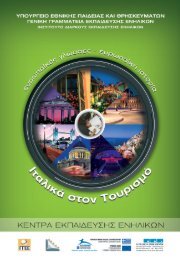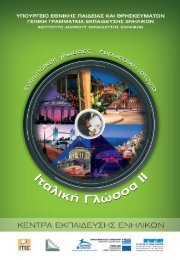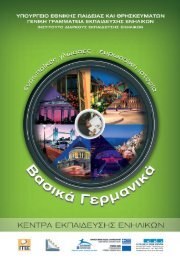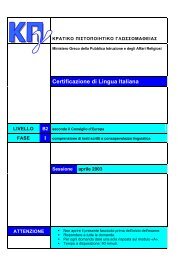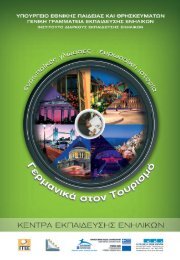Cataloging conventional and digital objects - Digital Library Logo
Cataloging conventional and digital objects - Digital Library Logo
Cataloging conventional and digital objects - Digital Library Logo
You also want an ePaper? Increase the reach of your titles
YUMPU automatically turns print PDFs into web optimized ePapers that Google loves.
<strong>Cataloging</strong> <strong>conventional</strong> <strong>and</strong> <strong>digital</strong> <strong>objects</strong>: new tools with old names or old names<br />
to new tools?<br />
Michalis Gerolimos<br />
Department of Archival <strong>and</strong> <strong>Library</strong> Sciences, Ionian University, Greece<br />
(mike@ionio.gr)<br />
George Papadourakis<br />
Department of Applied Informatics <strong>and</strong> Multimedia, Technological Educational Institute<br />
of Crete, Greece (papadour@cs.teicrete.gr)<br />
Michail Nikitakis<br />
<strong>Library</strong>, Technological Educational Institute of Crete, Greece (nikit@lib.teiher.gr)<br />
Anestis Sitas<br />
<strong>Library</strong>, Aristotle University of Thessaloniki, Greece (sitas@lit.auth.gr)<br />
Abstract<br />
Information concerning the creation of tools <strong>and</strong> bibliographic description st<strong>and</strong>ards of<br />
library material are referred. Detailed reference to their development <strong>and</strong> adjustment to<br />
the data created so as to reflect the new conditions <strong>and</strong> needs, the way these are formed in<br />
the contemporary environment, is made. We present the efforts made by the bibliographic<br />
agencies to develop new <strong>and</strong> to improve the traditional/<strong>conventional</strong> tools for the<br />
description of the <strong>conventional</strong> documents as well as the electronic resources available in<br />
the World Wide Web.<br />
1. Towards a <strong>digital</strong> information environment<br />
The current information environment, always in mutation, is in the process of change<br />
<strong>and</strong> readjustment of its constituent parts, mainly, due to the technological progress in the<br />
area of Communication Technologies. These technologies diversify it, by prompting it<br />
towards the incorporation of certain technological elements into the new work models<br />
<strong>and</strong> of the provision of services. In general terms, however, the present environment<br />
keeps the basic structure <strong>and</strong> the morphology of the <strong>conventional</strong>/traditional<br />
environment. Due to the established practices, as well as to the experience vested on<br />
fundamental matters of its administration, the current “hybrid environment” administers<br />
<strong>and</strong> develops models, practices <strong>and</strong> processes of two different but interrelated “worlds”,<br />
the <strong>conventional</strong> <strong>and</strong> the <strong>digital</strong> world.<br />
The main characteristic of the current environment of the libraries <strong>and</strong> the<br />
information agencies concern the form of the <strong>objects</strong> that compose their collections.<br />
Libraries, in addition to the <strong>conventional</strong> material, contain also new forms of documents,<br />
can use automated tools for metadata production – at least as far as the <strong>digital</strong> documents<br />
are concerned- aim at the fulfillment of the process of documents description as soon as<br />
1
possible <strong>and</strong> finally, libraries offer their services outside the <strong>conventional</strong> work<br />
environment.<br />
2. Bibliographic description<br />
The processing of a library’s documents through a series of procedures <strong>and</strong> the use of<br />
specific st<strong>and</strong>ards <strong>and</strong> tools so as for the information contained to become accessible to<br />
the users, is a relatively “recent” development in the area of libraries. The systematic<br />
processing of the material, aiming at the creation of access tools to the library material for<br />
the user, was introduced in the second half of the 19 th century along with the introduction<br />
of the first rules concerning the description of the bibliographic material. The<br />
bibliographic description of a document – of a publication - aims at its description as a<br />
bibliographic unit, the recording that is to say, all of the elements that attribute a unique<br />
identity to each document <strong>and</strong> to determine the access points, which enable its location.<br />
Moreover, the documents are given the possibility of topical access, since it is attributed<br />
the right term during its subject description. Although being different for each document,<br />
these elements altogether make up the “bibliographic record” which is added to the<br />
library catalog.<br />
3. Bibliographic catalogs<br />
The main tool <strong>and</strong> the main service with which the library material becomes<br />
accessible to its users is its catalog, which is the most important searching tool that allows<br />
the user to search for <strong>and</strong> retrieve its documents. The general process of the creation of<br />
catalogs followed in the course of time, is the following: Book catalog – Card catalog –<br />
Online Public Access Catalog (OPAC).<br />
The Book Catalog is the first attempt to create a tool for the recording of a<br />
collection’s material. It prevailed up until the 19 th century, when it was replaced by the<br />
Card catalog. The Card catalog constitutes the form of a library catalog that has<br />
dominated for almost a century, not only as a means of recording the documents, but also<br />
of the public’s access to them. In the early 80’s, due to the possibilities of<br />
computerization of the collections, the Card catalog began to be replaced by OPACs. The<br />
OPAC constitutes the tool to which the bibliographic data of a document is inserted in an<br />
electronic format in order for the user to be able to look it up in a computer, without<br />
restrictions of place or time.<br />
4. Conventional/Traditional cataloging tools<br />
4. 1. <strong>Cataloging</strong> Codes <strong>and</strong> ISBDs<br />
The bibliographic description, in other words the input in a catalog of the<br />
identification elements of a document, is done according to st<strong>and</strong>ard codes <strong>and</strong><br />
instructions, as they are determined by special tools <strong>and</strong> st<strong>and</strong>ards. For library cataloging,<br />
tools such as the AACR2, LCRI, MARCs, LCSH, LCC, DDC, etc., are used. The main<br />
tools of bibliographic description which are applied for the description of documents, or<br />
<strong>objects</strong>, are the cataloging codes/rules. Among the first cataloging codes, the most<br />
2
important was the Panizzi’s British Museum Rules for the Compiling of the Catalogue<br />
(1841) <strong>and</strong> Cutter’s Rules for a printed dictionary catalogue (1876). These rules had the<br />
greatest effect on the later ones, such as the Anglo-American <strong>Cataloging</strong> Rules (ACCR).<br />
The AACR are detailed st<strong>and</strong>ard rules established in 1967 in order to catalog<br />
documents of the American, Canadian <strong>and</strong> British libraries <strong>and</strong> have been based on Paris<br />
Principles (1961). Very quickly, they took the form of “universal” rules, since they were<br />
adopted by many other countries. In 1978, they were published in a volume, followed by<br />
their revisions of 1998, in order to reflect the changes in formats, to which the<br />
information is now available. Their current publication is AACR2 Second ed., 2002<br />
Revision (with 2003, 2004, <strong>and</strong> 2005 updates) (AACR JCS, 2005). Rules concerning the<br />
Internet resources <strong>and</strong> other types of resources are included, without however constituting<br />
an entirely new code. The next edition, entitled “RDA - Resource Description <strong>and</strong><br />
Access”, is expected to be published in 2009. (AACR JCS, 2005)<br />
The need to st<strong>and</strong>ardize the cataloging processing on an international scale has leaded<br />
the IFLA (International Federation of <strong>Library</strong> Associations <strong>and</strong> Institutions) to the<br />
creation of a series of st<strong>and</strong>ards for bibliographic descriptions, known as International<br />
St<strong>and</strong>ard Bibliographic Descriptions (ISBDs). The ISBD is a group of st<strong>and</strong>ards whose<br />
creation started in 1971, having as an objective the preparation of the descriptive part of<br />
bibliographic records. The ISBD determines the structure that bibliographic records must<br />
have, the order of the elements of description <strong>and</strong> the punctuation system which offer the<br />
possibility to exchange bibliographic documents <strong>and</strong> to convert them into a format that is<br />
readable by a computer. (AACR2 Homepage, 2006) The incorporation of the ISBDs into<br />
the AACR2 structure has constituted one of the greatest developments in cataloging.<br />
The library collections, therefore the tools for bibliographic description, are<br />
determined by the format of the material included. While, initially, the collections were<br />
made of paper material, in the course of time new types of documents appear which lead<br />
to the creation of new tools, in order to make their library processing possible. The IFLA,<br />
driven by the increasing need for a separate ISBD concerning especially the computer<br />
files, published in 1990 the ISBD (CF- Computer Files). The electronic resources,<br />
however, are the products of a technology that is developing quite quickly. As a result of<br />
this assessment, IFLA decided to reassess <strong>and</strong> revise the ISBD (CF), which leaded in<br />
1997 to the publication of ISBD (ER- Electronic Resources). (IFLANET, 2005)<br />
Subject access tools<br />
The assignment of topical terms to the documents constitutes an effort of encoding<br />
their contents in order to make the search easier to the user. For their assignment, various<br />
tools have been created, which aim at the compilation of controlled vocabularies of<br />
topical terms assignment. The subject headings as well as the thesauruses are such tools.<br />
There are various tools for subject description of the documents available; among the<br />
most frequent are the <strong>Library</strong> of Congress Subject Headings (LCSH), the MeSH (Medical<br />
Subject Headings) <strong>and</strong> the Eurovoc.<br />
Although the creation <strong>and</strong> use of the LCSH started in 1897, their basic 9 th printed<br />
edition was published in 1980; now the 29 th edition is available. Apart from the printed<br />
format, the LCSH have been available in microform (microfilm <strong>and</strong> microfiche), from<br />
3
1976 to 2005 <strong>and</strong> in CD-ROM from 1988 to2005 as well. Since 1995, they are available<br />
via Internet <strong>and</strong> via the Classification Web. 1<br />
The MeSH are the subject headings created to be used by the National <strong>Library</strong> of<br />
Medicine (USA). The first printed edition was published in 1954 while the access to the<br />
online version is already available for free from the MeSH Website. 2 Finally, the<br />
EUROVOC is a multilingual thesaurus that covers all the European Union activity areas.<br />
It was created in 1982 <strong>and</strong> was first published in 1984. Its current edition, 4.2, is available<br />
in the 16 official languages of the E. U. <strong>and</strong> the access to the Eurovoc thesaurus<br />
webpage 3 is free.<br />
Several classification schemes add to the task of the subject description of the<br />
documents, such as the DDC, LCC, UDC etc. Among the most frequent used<br />
classification schemes is the Dewey Decimal Classification (DDC), whose development<br />
started in 1876 <strong>and</strong> the <strong>Library</strong> of Congress Classification (LCC), which was developed<br />
mainly between 1899-1940.<br />
5. Description tools in automated environments: MARC<br />
The software that automatizes the works in the libraries need to implement a st<strong>and</strong>ard<br />
for the automate data readout. The MARC (Machine Readable <strong>Cataloging</strong>) format gives<br />
this possibility. Its creation started from the <strong>Library</strong> of Congress (USA) in the 60’s with<br />
the creation of the LC-MARC format. This format, together with the identical CAN-<br />
MARC, has harmonized their differences, resulting, in 1999, in the publication of a<br />
volume entitled MARC21. In the meanwhile, other bibliographic agencies have been<br />
developed on over 20 different MARC formats, like the UKMARC, etc. In 1977, the<br />
IFLA tried to solve the problems caused by the number of deferent formats, their<br />
exchange <strong>and</strong> their compatibility, with the publication of the UNIMARC. In 1994 a<br />
newer <strong>and</strong> more complete edition of the UNIMARC was published.<br />
Since 1981 the ISO 2709 has been adopted, which has been replaced by ISO<br />
2709:1996 “Information <strong>and</strong> documentation - Format for Information Exchange”. It<br />
concerns an international exchange scheme <strong>and</strong> has actually originated from the original<br />
LC-MARC format. Its aim is to provide an internationally accepted st<strong>and</strong>ard, to which all<br />
the existing formats can be adapted.<br />
One of the most significant <strong>and</strong> indicative adaptation procedures of MARC to the<br />
new means of publication of the documents, started in 1993 <strong>and</strong> concerns the creation of<br />
a special field containing necessary information for the location <strong>and</strong> the access to<br />
electronic resources, with the use of the 856 field “Electronic Location <strong>and</strong> Access” in<br />
the USMARC formats. Right after, this field has been adapted by UNIMARC.<br />
6. Means of tools publication<br />
The <strong>conventional</strong> media of publications of all the tools is the printed edition. With the<br />
advance of the technology, these tools began to be available in other formats as well.<br />
Initially, they were transformed into microforms, but mainly into CD-ROMS, which gave<br />
1 LC, Classification Web, http://classificationweb.net/<br />
2 NLM, MeSH Browser, http://www.nlm.nih.gov/mesh/MBrowser.html<br />
3 Eurovoc thesaurus, http://europa.eu.int/celex/eurovoc/<br />
4
the possibility of their setting up in local networks. The best known relative service is the<br />
Cataloger’s Desktop, which, besides the cataloging rules, provides access to the most<br />
significant tools for its application. However, the format that gradually dominated is the<br />
access through the Web. The <strong>Library</strong> of Congress has stopped its publication in CD-<br />
ROM with issue 4 (2005) <strong>and</strong> the access is possible only through the web version 4 , <strong>and</strong><br />
also through the Classification Web, which provides access nearly to all services <strong>and</strong><br />
tools needed (classification schemes, subject headings, authority files, etc). This kind of<br />
access offers more developed many more possibilities, for example the hypertext linking<br />
between the AACR2 <strong>and</strong> the <strong>Library</strong> of Congress Rule Interpretations (LCRIs), etc.<br />
Nevertheless, in the new environment where the Internet is prevalent, there are many<br />
tools that, not only do they change the medium of availability, but can partially be<br />
replaced without cost, since the access to these tools is free <strong>and</strong> they can be used as<br />
alternative sources of information retrieval for the catalogers. Certain free access<br />
documents are identical with the commercially available ones. There are others that<br />
provide an acceptable substitute, like the Amazon.com, which, after its launching in 1995,<br />
can partially function as an alternative solution for the Books in Print. 5 (Arms, 2000).<br />
There are also other free sources offering help to catalogers without dem<strong>and</strong>ing<br />
subscription, such as the Online LC Catalog, the <strong>Library</strong> of Congress Authorities, the<br />
MARC21 Concise formats <strong>and</strong> UNIMARC formats.<br />
7. Search Engines vs Catalogs<br />
The evolution of the Web has had an influence on the libraries’ nature. The constant<br />
increase of <strong>digital</strong> <strong>objects</strong> (files, images, sound, computer software, multimedia, etc)<br />
available through the Web has led the libraries to the incorporation of the <strong>digital</strong> <strong>objects</strong><br />
to their collections. It is already being discussed that the libraries must move their interest<br />
from the strict keeping of the library rules to st<strong>and</strong>ards that can be supported by<br />
automated systems for organization of <strong>conventional</strong> or <strong>digital</strong> libraries. This fact often<br />
obliges the libraries to transpose their efforts from the strict keeping of the description<br />
<strong>and</strong> cataloging st<strong>and</strong>ards for the creation of their catalogs towards the implementation of<br />
a more flexible policy to describe all the types of documents.<br />
There are significant differences between the Web search engines <strong>and</strong> the catalogs,<br />
whether we are referring to the catalogs of <strong>conventional</strong> or <strong>digital</strong> libraries. Catalog is<br />
controlled for its quality <strong>and</strong> its bibliographic information is selected <strong>and</strong> is created on the<br />
basis of st<strong>and</strong>ard <strong>and</strong> generally accepted description rules. The use of the authority files,<br />
as well as, the assignment of the topical terms, the classification numbers, etc. lends<br />
quality to the information provision <strong>and</strong> the user’s search. Also, the procedure for the<br />
choice of the documents that precedes the cataloging is based on detailed selection <strong>and</strong><br />
evaluation of resources.<br />
On the contrary, the choice made for the documents that are indexed by a Web search<br />
engine, is often based on arbitrary assessments, the recalled records can be characterized<br />
as unelaborated, the control of the authority files does not exist <strong>and</strong> the reduction of<br />
duplicated records if far from the desired goal. On the other h<strong>and</strong>, however, the Web<br />
search agencies are proven to be powerful where the catalogs are weak. Although the<br />
4 Cataloger’s Desktop, http://www.loc.gov/cds/desktop/<br />
5 Books in Print Professional, http://www.booksinprint.com/bip/<br />
5
cataloging is expensive, the Web indexing is not. The most considerable Web search<br />
engines index many millions of websites, much more that the overall number of MARC<br />
records that could ever be created. But the Web’s great advantage is that everything one<br />
can find in its indexes is directly accessible. (Arms, 2000)<br />
Nevertheless, it would be wrong to claim that the <strong>conventional</strong> catalogs are superior<br />
due to their quality control, as it is equally wrong to claim that the Web search services<br />
are superior due to the low cost, the wide range of resources provided <strong>and</strong> the constant<br />
update. Their value depends on the degree of the user’s satisfaction. (Arms, 2000)<br />
8. Incorporating <strong>digital</strong> <strong>objects</strong> in library catalogs<br />
A considerable number of libraries have already incorporated many Internet<br />
information resources in their websites or in specialized portals. Some libraries have<br />
begun cataloging, with <strong>conventional</strong> means, the Internet resources that they consider<br />
useful for their users, incorporating in this way the bibliographic descriptions of these<br />
<strong>digital</strong> <strong>objects</strong> in their catalogs. Some other libraries register their bibliographic records<br />
in metadata repositories, so as for the records of their natural collections to be available in<br />
the same way <strong>and</strong> at the same time with the <strong>digital</strong> ones. (Grant Campbell <strong>and</strong> Fast, 2004)<br />
This leads to the need to have data bases that contain complex bibliographic descriptions<br />
based on different st<strong>and</strong>ards, accordingly to the type <strong>and</strong> the kind of each described<br />
object.<br />
9. Metadata<br />
For organizing traditional format documents, it has been sufficient to a certain degree,<br />
the use of tools used by professionals for the processing of the libraries’ material for<br />
decades. However, data as the author, the title <strong>and</strong> the topical terms are proven to be<br />
insufficient for many types of material, mainly as far as the <strong>digital</strong> <strong>objects</strong> is concerned.<br />
(Hunt <strong>and</strong> Ethington, 1997) In the <strong>conventional</strong> libraries, the creation of bibliographic<br />
records was, to a certain degree, limited <strong>and</strong> controlled. In the Internet, the lack of<br />
organizational control of the available search tools <strong>and</strong> search engines contribute to the<br />
ineffectiveness of the discovery of its resources. It seems that the most reliable approach<br />
for the discovery of the Internet resources is the application of procedures used by<br />
librarians for the description of <strong>conventional</strong> documents: the use of metadata. Metadata is<br />
the data for the data. More specifically, metadata is structured information that surrogates<br />
the real described object.<br />
9.1. Dublin Core Metadata Element Set<br />
The need to have a common description st<strong>and</strong>ard for all the concerned communities<br />
has led to the creation of st<strong>and</strong>ards that combine, not only the requirements of most of the<br />
communities, but also the need of a st<strong>and</strong>ard which can be at the same time simple <strong>and</strong><br />
applicable, without dem<strong>and</strong>ing high-level specialization. The descriptive metadata ranges<br />
from the very enriched <strong>and</strong> high value, for example the MARC format <strong>and</strong> the TEI<br />
headers, to the relatively simple one with 15 elements Dublin Core (DC). The creation of<br />
DC Metadata Element Set started in 1995 by OCLC in collaboration with other<br />
6
organizations. Its aim is to describe <strong>and</strong> locate the Web <strong>digital</strong> <strong>objects</strong> in order to<br />
constitute a simple descriptive tool which will make the object description <strong>and</strong> recovery<br />
easy. It can be encoded in HTML or XML, formats that are more applicable than the<br />
MARC formats, which are limited in the libraries’ communities. (Lee-Smeltzer, 2000)<br />
9.2. MARC, XML <strong>and</strong> RDF implementations<br />
The MARC formats constitute the foundations of library automation. The availability<br />
however of the XML (eXtensible Markup Language) <strong>and</strong> RDF (Resource Description<br />
Framework) language, seems to form a dynamic development that gives programming<br />
new possibilities. The XML was created for the h<strong>and</strong>ling of electronic publication; in this<br />
way the information of the structured documents can be used in the Web. It is a new<br />
language describing the Web resources, that is a useful component for the description of<br />
its field <strong>and</strong> leads to what we call Semantic Web. The RDF is a language for representing<br />
information about resources in the Web, like title, author, modification date of a site, <strong>and</strong><br />
information concerning copyright issues of the content of that site. Is a data integration<br />
mechanism between applications <strong>and</strong> the Web, is the language in which Semantic Web<br />
meta-data statements are expressed. It provides the ability to transfer data between<br />
various formats <strong>and</strong> allows late binding of application schemas to that data. (Manola <strong>and</strong><br />
Miller, 2004) The XML <strong>and</strong> the RDF are not metadata formats, but general data formats<br />
that can be used in any application. (Coyle, Feb. 2005)<br />
The efforts of creating software for the transformation of MARC records into XML,<br />
have started since the late 90’s. The <strong>Library</strong> of Congress Network Development <strong>and</strong> the<br />
MARC St<strong>and</strong>ards Office develop the MARCXML, which allows the MARC records to<br />
be encoded in XML. In addition, the LC, since 1995, has created the DTDs that allowed<br />
the conversion of MARC data into SGML. With the development of technology, this<br />
SGML DTD turned into XML DTD, which has been available for trial use since May<br />
1993. Additionally, in 2004, the IFLA, in an effort to adjust the tools that it develops, in<br />
collaboration with the <strong>Library</strong> of Portugal <strong>and</strong> the BookMARC, have created a prototype<br />
of UNIMARC manual in XML.<br />
9.3. MODS & METS<br />
The MODS 6 (Metadata Object Description Schema) is compatible with XML <strong>and</strong><br />
XML MARC <strong>and</strong> its goal is to carry selected data from the existing MARC 21 records<br />
<strong>and</strong> to allow the creation of original resource description records. For the electronic<br />
resources, it is particularly useful in the cases where the records must be transferred with<br />
the use of the XML schema language. In 2002 it became publicly available for trial use.<br />
The newest version of the scheme is version 3.1 which was released in July 2005.<br />
The METS 7 (Metadata Encoding & Transmission St<strong>and</strong>ard) provides a XML<br />
documents format for the encoding of the metadata needed for the <strong>digital</strong> <strong>objects</strong><br />
management of the libraries in a repository <strong>and</strong> for their exchange between different<br />
6<br />
The <strong>Library</strong> of Congress, MODS, Metadata Object Description Schema official website,<br />
http://www.loc.gov/st<strong>and</strong>ards/mods/<br />
7<br />
The <strong>Library</strong> of Congress, METS, Metadata Encoding & Transmission St<strong>and</strong>ard official website,<br />
http://www.loc.gov/st<strong>and</strong>ards/mets/<br />
7
epositories (or between the repositories <strong>and</strong> their users). It doesn’t include descriptive<br />
metadata, for the output of which various st<strong>and</strong>ards can be used, such as usually the DC<br />
<strong>and</strong> the MODS.<br />
9.4. TEI (Text Encoding Initiative)<br />
The existence of the Web <strong>and</strong> the possibilities it gives for direct <strong>and</strong> dynamic<br />
publication, have led to the creation of a complex repositories of full documents. The<br />
bibliographic description no matter how well it represents the document, it remains a<br />
simple description, which keeps on not providing the essential point for the user: the<br />
direct access to the document. For this reason, the scientific community was led to the<br />
research to encode the full document, providing other dimension <strong>and</strong> other dynamics to<br />
the access, its use <strong>and</strong> its processing. One of its aims is to use the information given by<br />
the full document at the library catalogs. TEI 8 is an effort started in 1987 <strong>and</strong> has become<br />
a powerful means of research, of indexing <strong>and</strong> of information storage. It is compatible,<br />
initially with the SGML language <strong>and</strong> then with the XML. The TEI header <strong>and</strong> the<br />
MARC record can exist in a parallel way, since none of them replace the other <strong>and</strong> it is<br />
allowed to create a connection between the TEI document <strong>and</strong> the corresponding MARC<br />
record. (McCallum, 2004)<br />
10. Automatic metadata creation<br />
The majority of the libraries support warmly the idea that the libraries can create the<br />
metadata for the total amount of their material <strong>and</strong> to make them available in the Web,<br />
without having to sacrifice the necessary descriptive st<strong>and</strong>ards. The libraries hold a<br />
tradition in the creation of bibliographic catalogs, with the use of well-tried <strong>and</strong> effective<br />
tools. However, problems arise in the new environment, which tries to incorporate more<br />
<strong>and</strong> more types of documents.<br />
The most serious problem concerning the location of the Web resources still is the<br />
lack of use of effective controlled vocabularies (like DDC, LCC, LCSH) for subject<br />
access. The automatic production of metadata needs to be investigated in depth, mainly<br />
due to the reduction of cost that its application brings about. Nevertheless, at least for<br />
now, we shouldn’t overlook the fact that more complete results are attained only with the<br />
supplementary application of human <strong>and</strong> automatized methods. (Greenberg, Spurgin <strong>and</strong><br />
Crystal, 2005) These descriptions can be generated by the producers of the documents, at<br />
the point of posting the resource on the Internet; they can be automatically generated by<br />
intelligent software agents or produced by the librarians. Afterwards, the librarians can<br />
correct or enrich the record. (Lee-Smeltzer, 2000)<br />
11. Conclusions<br />
Libraries <strong>and</strong> communities of information services can play a significant role, not<br />
only in the supply of bibliographic services, but also in the services that offer direct<br />
access to all the information contained in a <strong>digital</strong> object. It can work for the integration<br />
or the adaptation <strong>and</strong> the adjustment of the traditional tools in the bibliographic<br />
8 The Text Encoding Initiative, http://www.tei-c.org/<br />
8
description area. It ought to research the development of automatized <strong>and</strong> the production<br />
of new tools, such as the FRBR (Functional Requirements for Bibliographic Records)<br />
recommended by the IFLA <strong>and</strong> is about a new view of the cataloging function in the new<br />
environment <strong>and</strong> the new needs.<br />
In order for the libraries to h<strong>and</strong>le effectively the Internet collections, it is necessary<br />
to put into practice simple organizational structures <strong>and</strong> to present them in such a way,<br />
that they can be useful <strong>and</strong> intelligible to the users of both <strong>conventional</strong> <strong>and</strong> <strong>digital</strong><br />
libraries. Passing from the <strong>conventional</strong> to the <strong>digital</strong> information environment <strong>and</strong><br />
covering the current hybrid environment, that is to say the environment where<br />
institutions, tools <strong>and</strong> practices coexist, we have to be able to turn to make productive the<br />
advantages <strong>and</strong> the possibilities that it offers. Keeping in mind that this has to remain<br />
stable, by adjusting the ones having this potential, by setting aside the old practices <strong>and</strong><br />
the tools when the old ones are not in the position to satisfy the new needs, but at the<br />
same time by creating new tools when need arises.<br />
Bibliographical references<br />
[Last access to all documents: 3/05/2007]<br />
1. AACR JCS, A brief history of AACR (2005) [available at:<br />
http://www.collectionscanada.ca/jsc/history.html]<br />
2. AACR JCS, RDA: Resource Description <strong>and</strong> Access,<br />
(http://www.collectionscanada.ca/jsc/rda.html)<br />
3. AACR2 Homepage, http://www.aacr2.org/access.html<br />
4. Arms, William Y. (July/Aug. 2000), Automated <strong>digital</strong> libraries: how effectively can<br />
computers be used for the skilled tasks of professional librarianship?, D-Lib<br />
Magazine, 6 (7/8) [available at: http://dlib.org/dlib/july00/arms/07arms.html]<br />
5. BookMARC, The UNIMARC <strong>and</strong> MARC21 manual in XML: automating validation,<br />
explanation <strong>and</strong> help systems for bibliographic records, [available at:<br />
http://www.bookmarc.pt/unimarc/]<br />
6. Carvalho, Joaquim (2005). An XML representation of the UNIMARC Manual: a<br />
working prototype, 71st IFLA General Conference, [available at:<br />
http://www.ifla.org/IV/ifla71/papers/199e-Carvalho.pdf ]<br />
7. Coyle, Karen (Feb. 2005). Underst<strong>and</strong>ing metadata <strong>and</strong> its purpose, The Journal of<br />
Academic Librarianship, 31 (2): 160-163<br />
8. Coyle, Karen (Jan 2005). Catalogs, card <strong>and</strong> other anachronisms, The Journal<br />
of Academic Librarianship, 31 (1): 60-92<br />
9. Grant Campbell, D. <strong>and</strong> Karl V. Fast (2004), Academic libraries <strong>and</strong> the Semantic<br />
Web: what the future may hold for research-supporting library catalogues, The<br />
Journal of Academic Librarianship, 30 (5): 382–390<br />
10. Greenberg, Jane, Kristina Spurgin <strong>and</strong> Abe Crystal (2005) AMeGA Final report,<br />
http://www.loc.gov/catdir/bibcontrol/lc_amega_final_report.pdf<br />
11. Hawkins, Les (Oct.-Dec. 2000), Refinement of cataloging tools, Serial Review, 26<br />
(4): 37-41<br />
12. Hawkins, Les (Spring 2003), Program for cooperative cataloging tools related to the<br />
2002 Revision of AACR2, Serial Review, 29 (1): 40-42<br />
9
13. Hunt, Leta (Li) <strong>and</strong> Philip J. Ethington (Nov. 1997), The utility of spatial <strong>and</strong><br />
temporal organization in <strong>digital</strong> library construction, The Journal of Academic<br />
Librarianship, 23: 475-483<br />
14. IFLA, Functional Requirements for Bibliographic Records: final report (1998).<br />
München: IFLA Section on Cataloguing, K. G. Saur [available at:<br />
http://www.ifla.org/VII/s13/frbr/frbr.pdf]<br />
15. IFLANET, Family of ISBDs (2005) [available at: www.ifla.org/VI/3/nd1/isbdlist.htm]<br />
16. Lee-Smeltzer, Kuang-Hwei (Janet) (2000), Finding the needle: controlled<br />
vocabularies, resource discovery, <strong>and</strong> Dublin Core, <strong>Library</strong> Collections, Acquisitions,<br />
<strong>and</strong> Technical Services, 24 (2): 205-215<br />
17. Manola, Frank <strong>and</strong> Eric Miller (eds) (2004) RDF Primer, [available at:<br />
http://www.w3.org/TR/rdf-primer/]<br />
18. McCallum, Sally (2004). Recent Developments in MARC with XML [available at:<br />
http://www.loc.gov/acq/conser/MARC-overview.html<br />
19. OCLC Research Activities, IFLA’s Functional Requirements for Bibliographic<br />
Records, [available at: http://www.oclc.org/research/projects/frbr/default.htm]<br />
20. Taylor, Arlene G. (2004). Wynar’s introduction to cataloging <strong>and</strong> classification, 9 th<br />
rev. ed. Westport, Conn.: Libraries Unlimited, 2004<br />
21. The <strong>Library</strong> of Congress, MARC st<strong>and</strong>ards, http://www.loc.gov/marc/<br />
22. The <strong>Library</strong> of Congress, MARC XML, MARC21 XML Schema official website,<br />
http://www.loc.gov/st<strong>and</strong>ards/marcxml/<br />
10





